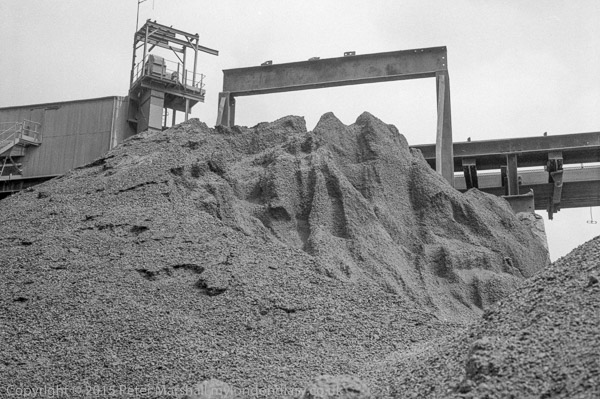
Granite Wharf, Greenwich. 1980
One of the hardest things about putting a book like Deptford to Greenwich together is the pictures you have to leave out. Back in the 1970s and 1980s I didn’t take many pictures, not least because even buying film in bulk still worked out too expensive for me to be profligate, but there were still quite a few that didn’t made the final edit of around 80 images.
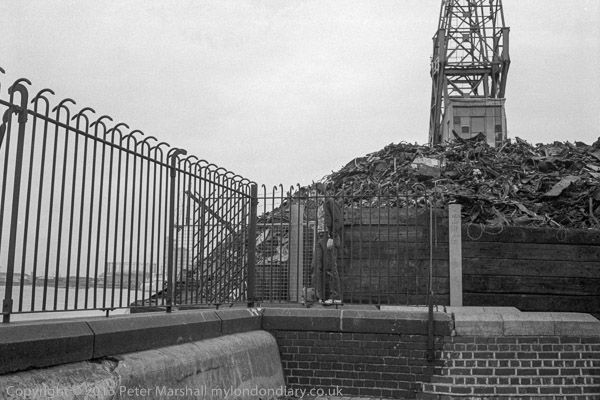
Greenwich. 1979
My first decision was not to use any of the small amount of colour work. Although at the time I mainly worked in colour, almost always I would have with me a second body loaded with colour film. Before 1985, for me that meant colour transparency, usually one of the E4/E6 films that could be bought in bulk rolls and then loaded in into casettes in the same way as the black and white film. And as with black and white, I processed the films at home.
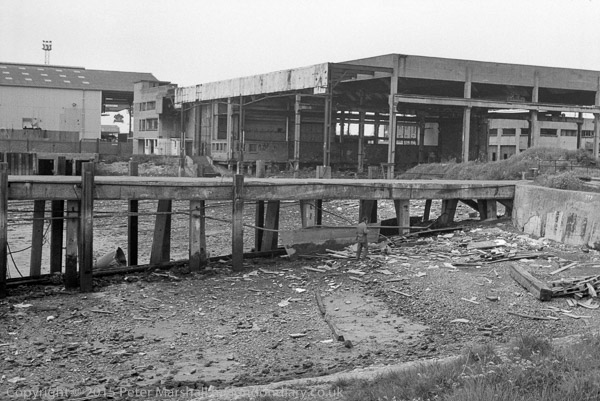
Horseshoe Breach, Greenwich. 1980
At first I used a bulk film loader, a plastic box with a light-trapped chamber for the bulk film, which led into a smaller lightproof area which accomodated the cassette. The film coming out through the light trap was taped to the spool of the cassette, which was then assembled around it, pushed into place and the lid closed. A hold leading to the centre of the spool allowed you to fit a handle, which was then turned to roll the film from the main box around the spool. Some had a ‘frame counter’ but otherwise you just counted the correct number of turns before opening the lid and cutting the film, the end of which was then trimmed to give the right shape for loading into the camera.
Buying film in bulk cut the cost to less than half that of pre-loaded casettes, but there were downsides. Using the loader conventionally meant that the last frame or two of each loaded film was exposed to light. I would load perhaps 38-40 frames of film, and try to remember to stop taking pictures at frame 36, but it was hard to stop before the end of the film, and many end frames were all or partly lost. There was also the danger of dirt in the felt light-trap of the cassette, often resulting in scratches as the film was loaded and again when taking pictures and rewinding in camera.
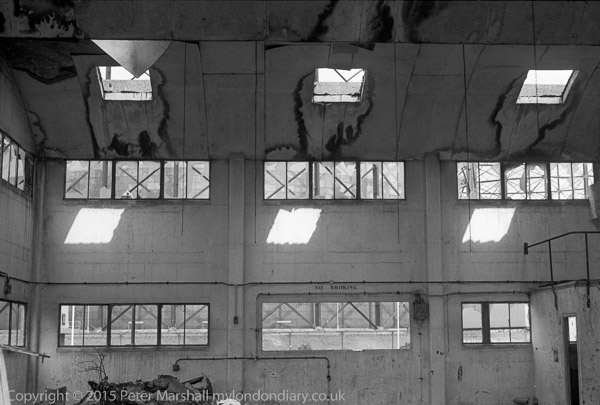
Horseshoe Breach, Greenwich. 1980
It was tedious, but necessary to very carefully clean the cassettes before reloading, and I seldom suffered from scratches. To avoid exposing the final frames, I moved on to using the bulk loader in total darkness (tricky but possible) or loading the film without a bulk loader again in totally dark conditions. A nail on the wall to hang the end of the film on, another the correct distance below to find and cut against, then taping the film to the spool, winding it around and fitting on the cassette shell in total blackness was possible, and I got to prefer it to using the bulk loader. Though it got rather tedious loading the 19 cassettes which I got from a tin of film. You could at least then turn on the light to cut the leaders.
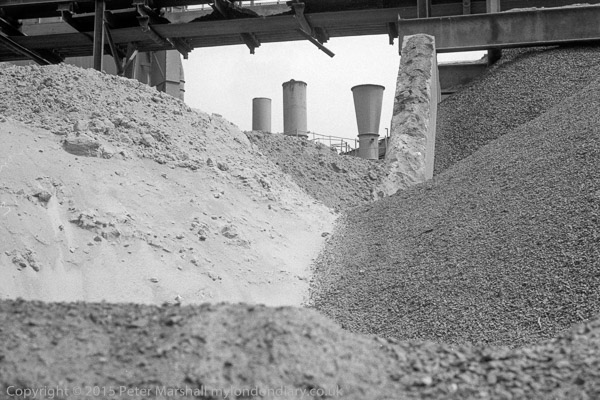
Granite Wharf, Greenwich. 1980
So often I’d spend a day taking pictures, and only make perhaps 70 or 100 exposures, sometimes even less. Some days much less, though still rather more than those few occasions when I worked with 4×5 film, when I had only half a dozen dark slides and a Grafmatic magazine with me.
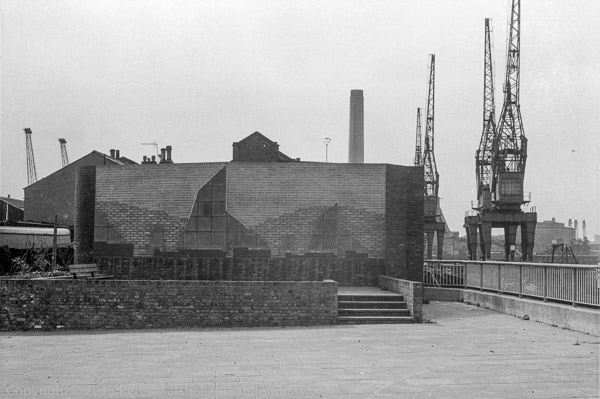
Wood Wharf. Greenwich. 1980
Because for me film was still expensive I seldom took more than one frame of any particular subject, and often that wasn’t quite right. Now, at least with static subject matter, I’ll take several frames until I’ve convinced myself that I have got the picture I want – and of course I can look at the image to see, though usually I know and don’t look. But there were still quite a few images that got edited out because they were just too similar to others.
Some of the pictures were now of less interest to me. Those where I was concentrating on things that really seem now to have little real connection with the area, perhaps some scrawls on a wall or a pattern of light, often the ‘artier’ side of my image-making. Perhaps where I was concentrating on pictures rather than on the subject.
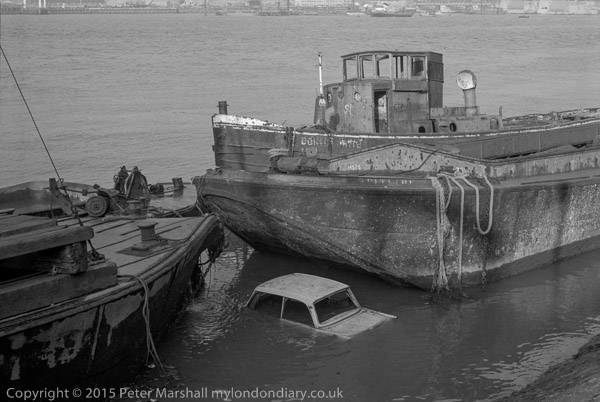
New Charlton. 1982
Others where where I’d taken different pictures of more or less the same subject, perhaps from a different angle or in different light. In the book there are some examples I’ve included – for example three quite different images of the giant concrete silos, but often I’ve decided one image was enough and have left out others. It hurts when some of those that I’ve left out were pictures I like.
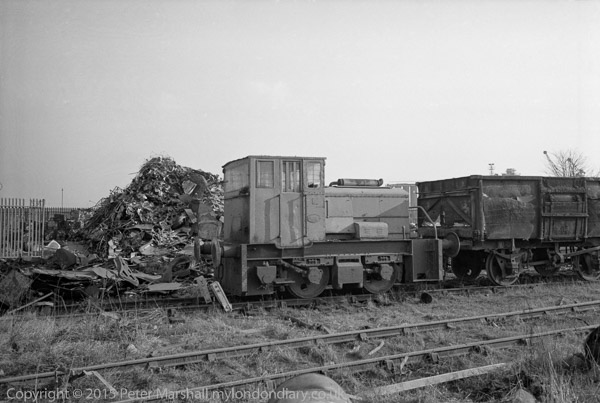
Angerstein Wharf, New Charlton. 1982
Anyway, the images above are the first of perhaps several batches of those that got left out. These are some of the earlier images, taken in 1979 to 1982.
______________________________________________________
My London Diary : Buildings of London : River Lea/Lee Valley : London’s Industrial Heritage
All photographs on this and my other sites, unless otherwise stated, are taken by and copyright of Peter Marshall, and are available for reproduction or can be bought as prints.
To order prints or reproduce images
________________________________________________________
Got to your website from the Deptford Dame.
Remarkably – your picture ‘Riverside view, Riverside Walk, Greenwich (1982)’ – I took a picture from a very similar position and probably within a few days of you because the earth was still left out of the hole for the insertion of a new lamppost!
Let me have a contact where I can send you a picture and I show you mine!
Hi, interesting to hear others were taking similar pictures at the time. Do you have a web site with your work?
There is a link at
http://buildingsoflondon.co.uk/comments.htm#comments
you can use to contact me directly.